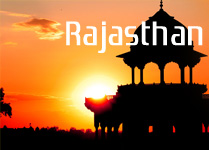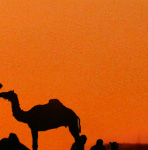 The scorching heat of the sun shining right above the hands, vast tracts of land with just sand all around with an occasion interruption of rippling sand dunes, where the life-giver water is scarce and the only vegetation generally found are the thorny bushes marks the landscape of a desert and so it is in the desert of That. Except for few things that makes it stand apart. Add to this picture, people wearing brightly hued costumes, women in their ghagharas wearing heavy jewellery and hiding their faces in veil, magnificent and majestic forts and palaces that are splendid examples of architecture, the haunting music and songs and performers that seem to be made of rubber as they dance and perform feats of acrobatics, the hunch-backed camels, royal kings seated on richly bedecked elephants and many, many legends that are an inseparable part of a rich culture and you get the picture of the Thar desert in Rajasthan.
The scorching heat of the sun shining right above the hands, vast tracts of land with just sand all around with an occasion interruption of rippling sand dunes, where the life-giver water is scarce and the only vegetation generally found are the thorny bushes marks the landscape of a desert and so it is in the desert of That. Except for few things that makes it stand apart. Add to this picture, people wearing brightly hued costumes, women in their ghagharas wearing heavy jewellery and hiding their faces in veil, magnificent and majestic forts and palaces that are splendid examples of architecture, the haunting music and songs and performers that seem to be made of rubber as they dance and perform feats of acrobatics, the hunch-backed camels, royal kings seated on richly bedecked elephants and many, many legends that are an inseparable part of a rich culture and you get the picture of the Thar desert in Rajasthan.The legend related to the origin of Thar Desert is not less interesting. In Ramayana, it is mentioned that when Lord Rama had to cross the ocean with his army to Lanka, the kingdom of the demon-king Ravana who abducted his wife, Devi Sita, he decided to use a fire-weapon and dry up the ocean. All the living creatures of the ocean were much frightened for their lives and started pleading him not to do so. But as it was impossible to dismount the arrow-weapon, once it was withdrawn, he decided to point it to a distant sea and released it. That sea happened to be in the place, where Thar Desert now exists. Though, it is mythology, the more interesting part is that fossils have been excavated in this region that indicate the existence of marine life here once.
Recent excavations have also unearthed the remains of the Indus Valley Civilization that existed 4,500 years ago that penetrated deep into the arid desert region. With the rising of the trade and commerce, traders traveled frequently crosses this desert in caravans, in the search of new markets for their products. With time, sarais or rest houses sprang up on the route, which slowly swelled into settlements. Then, there was much plundering and looting on the way and settlers offered security services to the traders in exchange of money in the form of taxes on their goods as they pass through their territory. Most of the rulers of the region belonged to the Rajput clan who had come to the region for refuge and to settle down once more and lay the foundations of new kingdoms, after they had been dethroned from their seat of powers by their foes. They built grandiose citadels and rose to power once again and thus, Rjasthan, the land of rulers, came into being.
Today, Rajasthan's folklores and folk songs are rich which chivalry, valor and romance of these Rajput kings and beauty, sense of fidelity the pride of their queens who would rather commit jauhar (self-immolation) in the hour of defeat of their men than allow the hands of the enemy as much as touch them. Rajput rulers proved themselves to be great patrons of art, architecture and religion, which can still be seen in the form of magnificent palaces, splendid temples and various forms of arts and crafts including dances, paintings and stone carvings of the state.
Today, Rajasthan is a tourist's paradise with its palace complexes that have been turned into hotels and museums and camel, jeep and elephant safaris that transport the guests to another level of human existence.














